What Every Gardener Should Know To Stop The Box Tree Moth In Its Tracks
We may receive a commission on purchases made from links.
If your gorgeous boxwood (Buxus species) hedges are suddenly suffering, the box tree moth (Cydalima perspectalis) might be to blame. If you've never heard of the box tree moth, that's probably because it's a more recent pest problem. Native to China and Korea, the box tree moth spread to Europe in 2006 and the United States in 2021. They feed primarily on boxwood hedges, which are especially loved in formal gardens, as this popular evergreen shrub is perfect for plant sculpting. It's important to check your boxwood hedges regularly because it's easier to deal with boxwood moths at the beginning of an infestation. Box tree moths are also a federally regulated species, so it's necessary to report outbreaks to your local Department of Agriculture.
The first sign of a boxwood moth infestation is often leaves eaten down to just the midrib, leaving behind distinctive curled remains. This is a clear indication that boxwood moth caterpillars have been feeding and damaging your hedges. If you suspect an infestation, gently lift the leaves to check inside the plant for webbing left behind by the caterpillars. These caterpillars are easily identified by their black and green coloring, with stripes running lengthwise along their bodies. If your caterpillar infestation has been going on for a while, your whole shrub may look brown and shriveled. You will need to take steps such as pruning and picking off the caterpillars to stop the infestation before it kills your boxwood shrubs.
What to do when you first spot boxwood moths
A few preventive steps can help keep boxwood tree moths away from your shrubs. Knowing how to properly care for boxwood shrubs is key to keeping them strong and resistant to pests. In the spring, boxwoods can be pruned to their desired shape, but this can also accidentally spread disease. Before pruning your boxwood, you should disinfect your tools using a solution of alcohol or bleach, such as Clorox Clean-Up All Purpose Cleaner with Bleach, available on Amazon, and then clean your pruners periodically throughout the process. You can also try this simply genius vinegar trick that stops caterpillars from munching on plants in your garden. This will help keep your boxwoods pest-free.
If you do find a small infestation, you can start by picking the caterpillars off your shrub and killing them, either by freezing them in a plastic bag or dropping them in soapy water. Then, carefully prune any infected branches, bagging the pieces to prevent accidentally spreading the boxwood tree moths further. This may be enough to stop the box tree moths in their tracks, but you could also consider spraying your boxwoods with an insecticide, such as Azera Gardening 8 oz or Bonide All Season Horticultural & Dormant Spray Oil. Always be sure to follow the package directions and use appropriate personal protective equipment, such as protective gloves, a mask and eye protection. These strategies can help you deal with a minor box tree moth infestation early.
How to deal with a boxwood moth infestation
If the boxwood moths have spread over the entire plant, it will likely be browning and covered in webbing. If the infestation is bad enough, your boxwood shrubs may need to be cut down and destroyed. First, bag the plant pieces while you prepare to deal with them, and consider placing the bags in the sun, as the heat may kill some of the insects. Then, you can bury the infected parts, put them through a chipper, or burn them to completely eradicate the box tree moths.
Your garden layout may feel incomplete without your boxwoods. When you go to replant, it's advisable to choose a different species of plant that isn't affected by the moths but has a similar look, such as holly (Ilex aquifolium) or thuja (Thuja occidentalis). Taking these precautions will help do your part to prevent box tree moths from spreading further and destroying the local boxwood populations.


